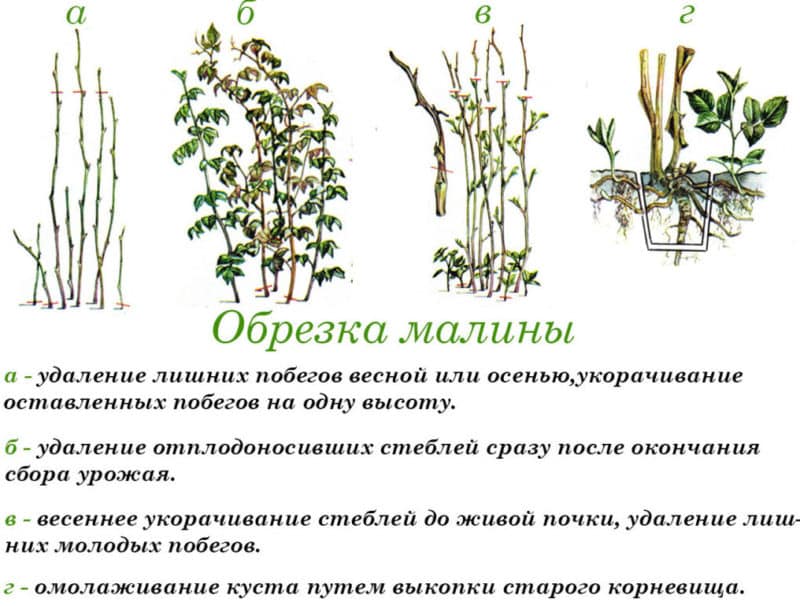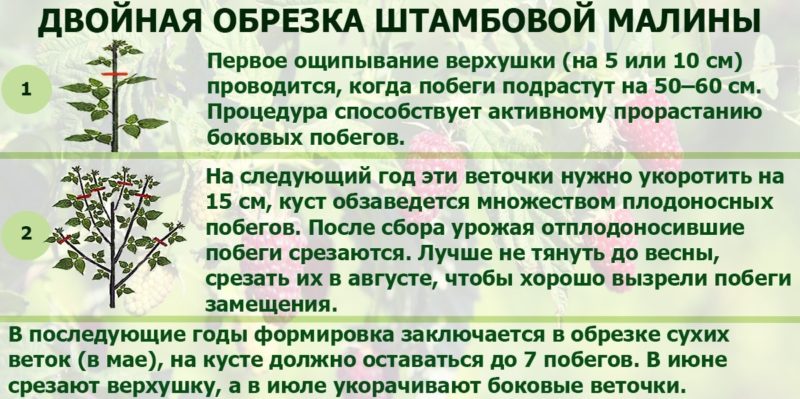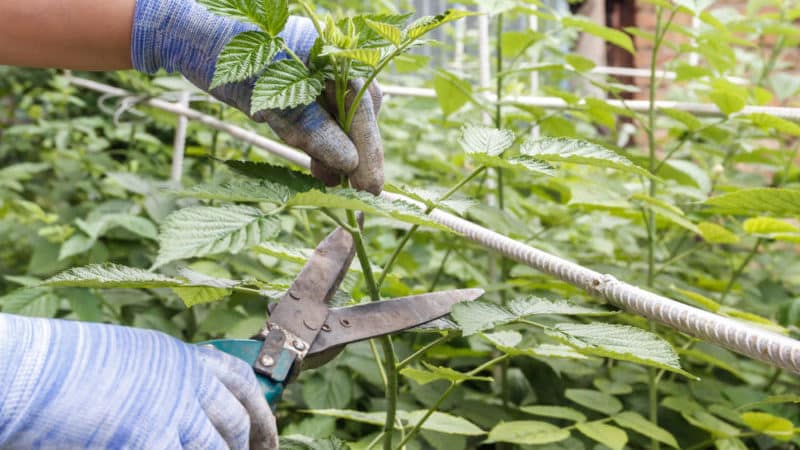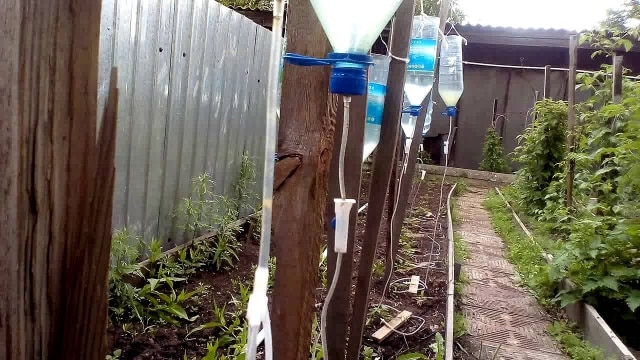How to properly prune raspberries in the summer in July and why it is necessary
Raspberries are among the unpretentious shrubs, but to maintain health and attractive appearance, regular pruning of the bushes is recommended. In summer, there is active growth of young shoots and a gain of green mass. Even bushes cut at the root in the fall grow quickly. Side shoots draw out juices and thicken the plantings. In the thickets, the formation of ovaries is suspended, and the growth of pathogenic flora is activated. Summer pruning strengthens young shoots, increases the plant's defenses and helps it survive the winter.
From the article you will learn whether it is possible to prune a bush in July, how to prune remontant raspberries and how to properly care for the plantation after the procedure.
Pruning raspberries in summer in July
Summer pruning of raspberries is one of the most important stages in caring for shrubs. During this period, the plant actively grows young shoots, which leads to thickening of the plantings, complicates access to the future harvest and creates a humid environment inside the bush.
As a result, the risk of spreading fungal infections and insect pests increases. Therefore, summer pruning is extremely necessary to maintain plant health, increase productivity, and improve aeration inside the bushes.
To ensure a good harvest, gardeners use the double pruning method. At the beginning of June, the tops of no more than 7 cm on shoots 1-1.2 m high are removed, which stimulates the supply of nutrients to the lateral buds. In autumn, young shoots up to 50 cm long will appear on them.
Before the onset of cold weather, young branches are bent to the ground and covered with non-woven fabric to protect them from frost. In spring, side shoots are shortened by 10-15 cm to stimulate the growth of new fruit-bearing branches.

Pruning goals
Pruning raspberries is aimed at rejuvenation, formation of bushes, disease prevention and increased productivity.
To increase the yield of ordinary raspberries, they practice cutting out obsolete branches. The peculiarity of this type of crop is the formation of fruit buds in the second year after planting.
After fruiting they die off, but are replaced by new stems growing from the root system. After timely pruning at the end of summer, young shoots will produce a large harvest the following season.
To prevent diseases and insects, perform sanitary pruning. Dense growth is regularly removed, ensuring optimal aeration inside the bush and exposure to sunlight. Preventative pruning helps prevent the development of diseases such as mosaic, anthracnose, leaf curl, and powdery mildew. Removing old two-year-old shoots makes harvesting easier and improves their taste. Thanks to better lighting, the fruits grow large and sweet.
The formation of the right bushes also contributes to the rejuvenation of the plant. After pruning, it looks neat: the number of thorny branches decreases, and young shoots develop better. At the same time, proper shaping of the bushes increases productivity.
Timing for pruning
July pruning of raspberries is carried out in dry weather - the shoots will warm up and dry out. In this form, they are easier to trim with pruning shears without splitting the plant fibers.
Favorable days
Adherents of gardening according to the phases of the moon advise adhering to the lunar calendar.
Favorable days for pruning raspberries in July:
- 2020 - 1-3, 7-12, 14-18, 22-31;
- 2021 - 4-8, 13-17, 19-23, 27-28, 31.
How to prune raspberries correctly
To ensure that raspberry pruning takes place without loss of productivity and quality of the bushes, experienced gardeners recommend using sharp tools, disinfecting compounds and acting strictly according to the instructions.
Required Tools
Equipment for pruning raspberries is pre-disinfected to prevent fungal infections. For gardening work use:
- Garden shears or pruning shears for removing young growth.
- Lopper for cutting thick branches.
- Knife for correcting uneven areas.
- Rake for collecting shoots and leaves.
- Medical alcohol, vodka, kerosene, 3% solution of copper sulfate or potassium permanganate for disinfecting equipment.
Step-by-step instruction

Raspberry pruning technology:
- Broken and diseased branches are removed completely - at the root, leaving no stumps.
- Weak shoots that do not have time to ripen before the onset of cold weather are cut off completely.
- Two-year-old stems are removed so that they do not shade the young shoots.
- Thickened plantings are thinned out, weeds are pulled out, excess bushes are cut down, digging around the tree trunk.
- Young growth is removed once every 2 weeks using a shovel. It is stuck into the ground at a slight angle and the roots of the young shoot are cut.
- Annual shoots are thinned out, leaving no more than 8 stems on the bush.
- The shoots are shortened by ¼ so that the height is no more than 1.5 m.
Features of pruning regular and remontant raspberries
To increase crop yields in central regions, gardeners use the Sobolev method. Garden work begins in late May - early June. Shoots 80 cm high are pruned by 10 cm to enhance the development of lateral branches by stopping the growth of the apex.
At the end of summer, 8 branches are formed on the bush. Next season, young side stems will reach 50 cm in height. Subsequently, they are shortened by 15 cm. The Sobolev pruning method turns ordinary raspberries into a remontant variety that bears fruit until the end of September.
Experienced gardeners use the triple pruning method - trimming the bushes in the spring, summer and autumn. By the end of the next growth period, the two-year-old stems are removed, and the remaining shoots are thinned out.
Remontant raspberries are especially popular among gardeners because they produce several harvests per season. The fruits are formed on annual stems, which are cut off at the root at the end of fruiting.
In the south of the country, remontant raspberries are not cut in July; all garden work is postponed until autumn. In the regions of the middle zone, pruning of this type of crop is carried out in the spring. It is not recommended to carry out the procedure earlier - young stems will sprout and winter hardiness will decrease.
Reference. Cumberland raspberries are distinguished by black fruits and fast growth. To increase productivity, two-meter stems are shortened by 20 cm, and young shoots are removed at the growth point at the end of June.
Nuances for bushes of different ages

Regular summer raspberries are planted in spring or autumn. The seedlings are shortened to 30 cm, planted in a strip method and wait for the first leaves to appear, which indicates that the plant has taken root. The main shoots growing from the roots are pruned to ground level so that they do not interfere with the growth of young branches on which fruit will appear next season.
Weak, diseased, damaged, excess stems are cut off without regret, because they become sources of infection. The more freely the shoots are placed, the larger the fruits. They are better heated by the sun, blown with air and do not rot. In autumn, all shoots are carefully tied to a trellis to facilitate further raspberry tree care. Long shoots are bent in an arc.
In the second and subsequent years, tied shoots are pruned to a strong bud in the spring before sap flow begins.. The procedure is aimed at stimulating lateral fruit-bearing shoots. In summer, standard rejuvenating and shaping pruning is performed.
Recently, gardeners have been practicing a new technology for pruning raspberries, which allows them to increase the volume of the harvest with fewer bushes. The technology involves pruning young shoots twice. The procedure is performed in June-July, depending on the growing region (in the south they start earlier, in the north and in the middle regions - later).
Young shoots of the first year of development will grow by 1-1.5 m, they are cut off by 5-7 cm from above. This approach stimulates the development of side shoots. In early spring, the second pruning is performed - the central conductor and side shoots are trimmed. At the time of budding, the raspberry bush will take shape and look neat - with many side shoots.
Installing a trellis is a mandatory procedure aimed at supporting branches covered with large fruits. If this is not done, the branches may break.
Post-procedure care

Raspberry is a moisture-loving shrub. For this reason, after pruning, it is necessary to maintain the optimal water balance of the plant. Raspberries love moderately moist soil and do not tolerate deficiency or excess moisture.In summer, especially in dry weather, the bushes are additionally watered with a hose or drip irrigation is installed on the plantation.
In conditions of moisture deficiency, the shoots dry out and the flower ovaries crumble. Dried roots lead to the death of the entire bush. Raspberries are watered 1-2 times a week from the end of May until the beginning of fruiting, avoiding stagnation of water. This causes root rot and reduced yield.
Sudden changes are dangerous for raspberries - from complete drying out of the soil to stagnation of water. Gardeners recommend forming a small mound of earth in the area of the tree trunk or fencing made of boards to retain moisture.
Reference. Mulching helps keep the soil moist, increase its fertility, and inhibit the growth of weeds and root shoots of the bush. A thick layer of mulch prevents the spread of shoot gall midges.
The mulch is laid out on the surface of the soil and periodically replaced with fresh mulch. Gardeners use rotted manure, peat, humus, straw or hay. It is recommended to add nitrogen under the straw to replenish its loss during its decomposition.
The soil in the tree trunk circle is loosened to a depth of 4-6 cm, in row spacing - 10-15 cm. Thickets reduce the productivity of raspberries, the fruits grow small and sour. The soil is loosened carefully so as not to damage the root system. The use of mulch eliminates the need to frequently loosen the soil and inhibits the growth of weeds.

Raspberries respond gratefully to organic fertilizers in liquid form. Particularly popular among gardeners are the preparations “Baikal EM-1” and “Gumat EM” for shrubs with micro and macroelements.
Mineral fertilizers are applied in early spring and June, potassium-phosphorus fertilizers - in July. Instead of potassium, wood ash is often used - 100-150 g per 1 m².For foliar feeding in July, use a urea solution (1 tablespoon per 10 liters of water). The solution is applied to the foliage in the evening.
After harvesting, all fruit-bearing branches are removed. If they are left, young shoots will not be able to develop normally in their shade. Young and strong branches are left.
The fruits are collected once every 2-3 days. They should be ripe and elastic. Overripe fruits lose their taste and crumble into mush. Some gardeners recommend picking raspberries every day. The optimal time for harvesting is dry, cloudy days, morning or evening.
Basic disease and insect control lead in early spring and late autumn.
At the first signs of infection in the summer, it is recommended to act as follows:
- During the budding period, the bushes are treated with a decoction of tomato tops. The product is effective against raspberry and strawberry weevil. After harvesting, the plant is sprayed with a 0.7% Karbofos solution.
- If blue discoloration is detected on young shoots, it is recommended to act quickly - cut off the affected shoots and burn them away from the plantation. This is a sure sign of raspberry gall midge infection.
- Free soil between rows is dug up deeply to destroy pest nests. This procedure is effective against flower beetle (raspberry-strawberry weevil), stem fly (affects shoot tips), shoot gall midge, and spider mite.
Advice from experienced gardeners
When growing raspberries, beginners encounter some difficulties, which advice from gardeners with extensive experience will help them overcome:
- If light green or light yellow leaves appear on the bushes, feed the raspberries with nitrogen.
- Fattening shoots with dark green leaves indicate excess nitrogen.
- Brown small leaves indicate potassium deficiency, which ultimately reduces the plant's winter hardiness. Thin and weak shoots indicate a lack of phosphorus.
- If the tops of the leaves turn yellow, feed the raspberries iron.
- Do not allow shoots to grow intensively - this leads to thickening of the plantings and deterioration of air circulation inside the bush.
- Remove diseased and dry shoots in a timely manner to maintain plant health.
- Once every 2 weeks, remove young shoots at a distance of more than 20 cm from the central conductor.
Conclusion
Summer pruning of raspberries in July is one of the most important care procedures. Removing fast-growing young growth, dry and damaged branches helps maintain the health of the bush. A pleasant bonus of July pruning is increased productivity, improved taste of the fruit due to optimal air circulation inside the bush.
Thinning the raspberry tree ensures that the berries are warmed by the sun's rays. Further care of the raspberry tree consists of moderate watering, adding organic and mineral fertilizing, mulching, loosening the trunk circle and row spacing, timely harvesting.